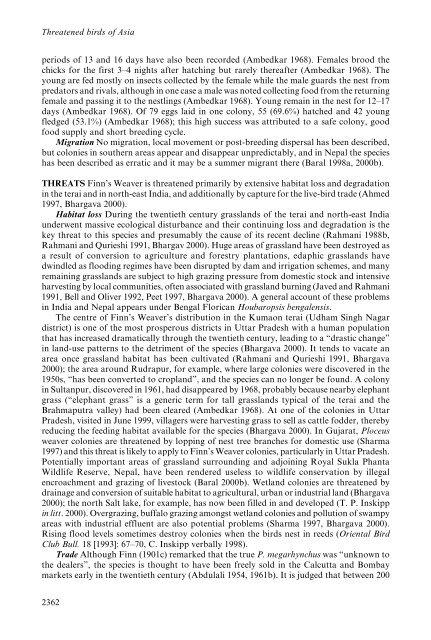Threatened Birds of Asia: - BirdLife International
Threatened Birds of Asia: - BirdLife International
Threatened Birds of Asia: - BirdLife International
Create successful ePaper yourself
Turn your PDF publications into a flip-book with our unique Google optimized e-Paper software.
<strong>Threatened</strong> birds <strong>of</strong> <strong>Asia</strong><br />
periods <strong>of</strong> 13 and 16 days have also been recorded (Ambedkar 1968). Females brood the<br />
chicks for the first 3–4 nights after hatching but rarely thereafter (Ambedkar 1968). The<br />
young are fed mostly on insects collected by the female while the male guards the nest from<br />
predators and rivals, although in one case a male was noted collecting food from the returning<br />
female and passing it to the nestlings (Ambedkar 1968). Young remain in the nest for 12–17<br />
days (Ambedkar 1968). Of 79 eggs laid in one colony, 55 (69.6%) hatched and 42 young<br />
fledged (53.1%) (Ambedkar 1968); this high success was attributed to a safe colony, good<br />
food supply and short breeding cycle.<br />
Migration No migration, local movement or post-breeding dispersal has been described,<br />
but colonies in southern areas appear and disappear unpredictably, and in Nepal the species<br />
has been described as erratic and it may be a summer migrant there (Baral 1998a, 2000b).<br />
THREATS Finn’s Weaver is threatened primarily by extensive habitat loss and degradation<br />
in the terai and in north-east India, and additionally by capture for the live-bird trade (Ahmed<br />
1997, Bhargava 2000).<br />
Habitat loss During the twentieth century grasslands <strong>of</strong> the terai and north-east India<br />
underwent massive ecological disturbance and their continuing loss and degradation is the<br />
key threat to this species and presumably the cause <strong>of</strong> its recent decline (Rahmani 1988b,<br />
Rahmani and Qurieshi 1991, Bhargav 2000). Huge areas <strong>of</strong> grassland have been destroyed as<br />
a result <strong>of</strong> conversion to agriculture and forestry plantations, edaphic grasslands have<br />
dwindled as flooding regimes have been disrupted by dam and irrigation schemes, and many<br />
remaining grasslands are subject to high grazing pressure from domestic stock and intensive<br />
harvesting by local communities, <strong>of</strong>ten associated with grassland burning (Javed and Rahmani<br />
1991, Bell and Oliver 1992, Peet 1997, Bhargava 2000). A general account <strong>of</strong> these problems<br />
in India and Nepal appears under Bengal Florican Houbaropsis bengalensis.<br />
The centre <strong>of</strong> Finn’s Weaver’s distribution in the Kumaon terai (Udham Singh Nagar<br />
district) is one <strong>of</strong> the most prosperous districts in Uttar Pradesh with a human population<br />
that has increased dramatically through the twentieth century, leading to a “drastic change”<br />
in land-use patterns to the detriment <strong>of</strong> the species (Bhargava 2000). It tends to vacate an<br />
area once grassland habitat has been cultivated (Rahmani and Qurieshi 1991, Bhargava<br />
2000); the area around Rudrapur, for example, where large colonies were discovered in the<br />
1950s, “has been converted to cropland”, and the species can no longer be found. A colony<br />
in Sultanpur, discovered in 1961, had disappeared by 1968, probably because nearby elephant<br />
grass (“elephant grass” is a generic term for tall grasslands typical <strong>of</strong> the terai and the<br />
Brahmaputra valley) had been cleared (Ambedkar 1968). At one <strong>of</strong> the colonies in Uttar<br />
Pradesh, visited in June 1999, villagers were harvesting grass to sell as cattle fodder, thereby<br />
reducing the feeding habitat available for the species (Bhargava 2000). In Gujarat, Ploceus<br />
weaver colonies are threatened by lopping <strong>of</strong> nest tree branches for domestic use (Sharma<br />
1997) and this threat is likely to apply to Finn’s Weaver colonies, particularly in Uttar Pradesh.<br />
Potentially important areas <strong>of</strong> grassland surrounding and adjoining Royal Sukla Phanta<br />
Wildlife Reserve, Nepal, have been rendered useless to wildlife conservation by illegal<br />
encroachment and grazing <strong>of</strong> livestock (Baral 2000b). Wetland colonies are threatened by<br />
drainage and conversion <strong>of</strong> suitable habitat to agricultural, urban or industrial land (Bhargava<br />
2000); the north Salt lake, for example, has now been filled in and developed (T. P. Inskipp<br />
in litt. 2000). Overgrazing, buffalo grazing amongst wetland colonies and pollution <strong>of</strong> swampy<br />
areas with industrial effluent are also potential problems (Sharma 1997, Bhargava 2000).<br />
Rising flood levels sometimes destroy colonies when the birds nest in reeds (Oriental Bird<br />
Club Bull. 18 [1993]: 67–70, C. Inskipp verbally 1998).<br />
Trade Although Finn (1901c) remarked that the true P. megarhynchus was “unknown to<br />
the dealers”, the species is thought to have been freely sold in the Calcutta and Bombay<br />
markets early in the twentieth century (Abdulali 1954, 1961b). It is judged that between 200<br />
2362
















